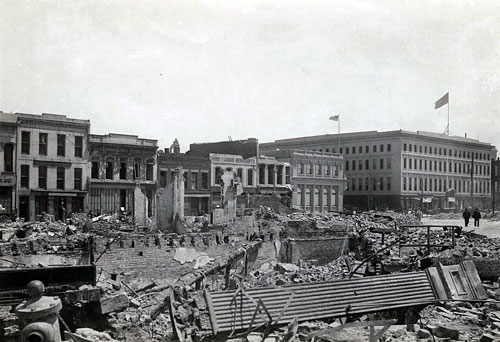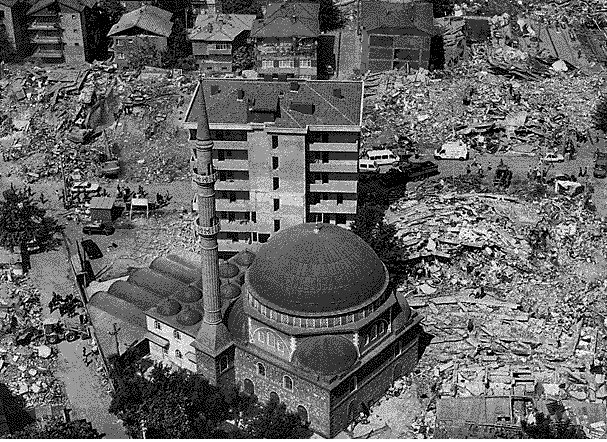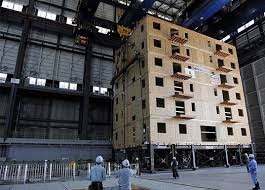There is a lack of significant research and seismic performance studies on the resiliency and inherent strength redundancy of older buildings.

U.S. Post Office & Courthouse, 7th &; Mission Streets, SF
In specific, the capacity of existing buildings to resist ground motion associated with earthquakes has not been fully developed or thoroughly researched. Based on damage from earthquakes, especially the 2010 Canterbury and 2011 Christchurch earthquakes in New Zealand, with additional seismic activity lasting nearly one year, the general thought is that older existing buildings perform poorly in response to ground motion. When analyzed further, the damage from the Christchurch earthquake was predominantly due to acceleration in a vertical direction, literally tossing buildings in to the air. The peak vertical acceleration during the Christchurch earthquake exceeded the design criteria for today’s modern buildings. Not lessening the severity of the event, nor proposing for less stringent seismic codes, the Christchurch earthquake would flatten most modern cities regardless of building age. Adequate resistance to vertical movement cannot be achieved with current engineering techniques and therefore research and performance studies regarding the resiliency of existing structures must concentrate on horizontal ground motion.

1906 earthquake, Montgomery Street block, SF
Because little can be done to prevent building collapse during vertical motion, seismic strengthening techniques focusing on dampening and resisting horizontal motion are applicable to existing structures as well as new structures. However, there has not been significant studies documenting and establishing the inherent strength to resist horizontal motion due to redundancy and mass of archaic construction methodologies. Independent performance evaluations of unique structures have occurred in the United State, Italy, Mexico, the Baltic, and others regions around the world without formal comparative analysis of the results or thorough in-depth dissemination and publication of the studies. For instance, in Oregon, informal static shear testing of a circa 1925 public middle school’s interior fire block and plaster wall surprised structural engineers when the walls did not crack at the shear planes (i.e. floor and ceiling connections) and strength measurements exceeded code allowance fivefold.
(2001 Portland Public Schools shear test) When calculated and tested, the ½ inch chalk boards added even more in-plane horizontal resistive strength. The result of the testing saved the school district approximately $ 1 million in seismic upgrade costs. There was no formal documentation of the result and there has been no known similar testing performed on other existing school properties.

The seismic resistance of existing structures is affected by the structural typology, the construction materials, the varying modifications, and deterioration and decay of materials over time resulting in unique conditions that are not readily transferrable to other structures. However, sporadic investigation and research performed on existing structures and published by the international RILEM Technical Committee 20 TBS in the article “Specific recommendations for the in situ load testing of dwellings and of public and industrial building structures,” and published accounts of independent studies in journals such as the Association of Preservation Technology Bulletin offer insight into the potential redundant strength capacity of existing structures to resist horizontal ground motion.
 These studies combined with documented field assessments and field evidence of older structures surviving earthquakes and repeated ground motion disturbances over several hundred years are available in numerous communities and offer case study structures for further research. The numbers of university engineering departments with “shake tables” (e.g. Portland State University) create opportunities for joint partnership with private sector consultants, public agencies, and professional organizations to assess and analyze the unique aspects of archaic building materials and methodologies for seismic response. The collaboration between university and private cooperation for seismic research has the potential to develop a wealth of practical and applicable information. The current collaborative efforts involving energy consumption offer the model from which to base seismic research.
These studies combined with documented field assessments and field evidence of older structures surviving earthquakes and repeated ground motion disturbances over several hundred years are available in numerous communities and offer case study structures for further research. The numbers of university engineering departments with “shake tables” (e.g. Portland State University) create opportunities for joint partnership with private sector consultants, public agencies, and professional organizations to assess and analyze the unique aspects of archaic building materials and methodologies for seismic response. The collaboration between university and private cooperation for seismic research has the potential to develop a wealth of practical and applicable information. The current collaborative efforts involving energy consumption offer the model from which to base seismic research.
A development of systematic research, publication, and dissemination of the inherent strength of existing structures to resist horizontal ground motion would benefit all communities across the globe.
Written by Peter Meijer AIA, NCARB, Principal



 These studies combined with documented field assessments and field evidence of older structures surviving earthquakes and repeated ground motion disturbances over several hundred years are available in numerous communities and offer case study structures for further research. The numbers of university engineering departments with “shake tables” (e.g. Portland State University) create opportunities for joint partnership with private sector consultants, public agencies, and professional organizations to assess and analyze the unique aspects of archaic building materials and methodologies for seismic response. The collaboration between university and private cooperation for seismic research has the potential to develop a wealth of practical and applicable information. The current collaborative efforts involving energy consumption offer the model from which to base seismic research.
These studies combined with documented field assessments and field evidence of older structures surviving earthquakes and repeated ground motion disturbances over several hundred years are available in numerous communities and offer case study structures for further research. The numbers of university engineering departments with “shake tables” (e.g. Portland State University) create opportunities for joint partnership with private sector consultants, public agencies, and professional organizations to assess and analyze the unique aspects of archaic building materials and methodologies for seismic response. The collaboration between university and private cooperation for seismic research has the potential to develop a wealth of practical and applicable information. The current collaborative efforts involving energy consumption offer the model from which to base seismic research.